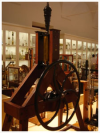How to move to fascination?
As other times in our tour, at the Fondazione Scienza e Tecnica in Florence Paolo Brenni discussed with us the concept of fascination in scientific museology. And as other times in our tour, there was a general consent on the fact that museums should consider fascination and emotion as more suitable to its cultural aims than plain didactic explanations. But how to move to fascination? At the FST, the method is pretty historical. FST is located in the old building of the first polytechnic school in Tuscany, and it preserves its entire collections of didactic instruments and technological tools. Even the showcases are original. This unique circumstance deserves particular attention. As Brenni said, “If you have the possibility to take hold of a time-machine of this kind, then you have to keep it”. Here, “keeping” means being very careful in restoration as well as in the disposition of special spaces according to historical documents. Aided by the curators’ noteworthy sensibility in lighting, history shows at FST its evocative power at its best. This crystallized space, which tells you a synchronic story of about one hundred and fifty years ago, makes somewhat ineffective the usual contradiction “didactic purposes vs. fascination”, or “understanding vs. engagement”. Here the fascinating power comes from didactic tools, though filtered by history, by a sort of temporal exoticism. Is it precisely this “exoticism” that fascinates? Or is it the idea of a “crystallized something” that defeats time while being out-of-time? What is the fascinating power of an historical object about?

